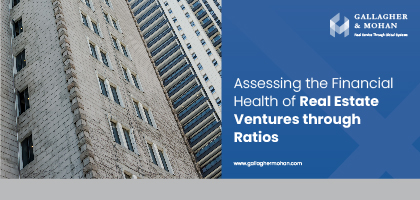14 March 2024
Stress Testing Strategies for Robust Real Estate Financial Analysis
Real estate financial analysis involves a complex interplay of market dynamics, economic factors, and property-specific variables. In this landscape, the concept of stress testing emerges as a crucial tool for fortifying financial strategies against unforeseen challenges. In this blog, we'll delve into the definition of stress testing in real estate financial analysis, explore its paramount importance in mitigating risks, and provide an overview of the strategies essential for developing a robust financial analysis framework.
What is Stress Testing in Real Estate Financial Analysis?
Stress testing is a method used to evaluate how a financial model or portfolio performs under adverse conditions. In the context of real estate, stress testing involves subjecting property investments and financial models to various hypothetical scenarios, assessing their resilience to economic downturns, market volatility, and other risk factors. It goes beyond traditional financial analysis by simulating extreme conditions to ensure preparedness for the unexpected.
Importance of Stress Testing for Mitigating Risks
The real estate market is inherently dynamic, influenced by factors ranging from interest rates and economic cycles to geopolitical events. In this ever-changing environment, the ability to foresee and navigate potential risks is paramount for investors, developers, and financial professionals. Stress testing serves as a proactive risk management strategy, allowing stakeholders to identify vulnerabilities, strengthen financial positions, and make informed decisions in the face of uncertainty.
This blog will focus on equipping real estate professionals with the tools and insights needed to conduct effective stress testing. We will explore the basics of real estate financial analysis, the intricacies of stress testing, and the development of a comprehensive framework tailored to the unique challenges of the real estate market. Through case studies, practical examples, and best practices, readers will gain a deeper understanding of how stress testing can be seamlessly integrated into their financial analysis toolkit. Stay tuned as we navigate the landscape of stress testing in real estate, aiming to foster resilience and ensure financial success in an unpredictable market.
Understanding Stress Testing in Real Estate
Stress testing in real estate is a proactive risk assessment technique designed to evaluate the resilience of financial models and property investments under adverse conditions. Unlike traditional financial analysis, which often relies on historical data and average assumptions, stress testing involves subjecting portfolios and models to extreme scenarios. The primary purpose is to uncover vulnerabilities that might not be evident in normal market conditions, providing a more comprehensive understanding of potential risks.
Common Stress Scenarios in the Real Estate Market
- Economic Downturns: Assessing the impact of a recession on property values, rental income, and overall market demand.
- Interest Rate Fluctuations: Examining the sensitivity of investments to changes in interest rates, which can affect financing costs and property valuations.
- Market Volatility: Simulating sudden market shocks, such as geopolitical events or economic crises, to evaluate the portfolio's ability to withstand unforeseen disruptions.
- Liquidity Crunch: Evaluating how easily assets can be sold or refinanced in a tight liquidity environment.
- Tenant Vacancy Spikes: Understanding the financial implications of increased tenant vacancies and the ability to attract new tenants during challenging economic conditions.
Also Read: Understanding Real Estate Market Cycles: Timing Your Investment for Success
Stress Testing and Risk Mitigation
Stress testing is intricately linked to risk mitigation in real estate. By identifying potential weaknesses and vulnerabilities through stress testing scenarios, stakeholders can proactively implement strategies to mitigate these risks. This could involve adjusting investment portfolios, optimizing debt structures, diversifying property holdings, or implementing contingency plans for various scenarios.
The link between stress testing and risk mitigation is not just theoretical; it is a practical approach to building resilience in real estate investments. The insights gained from stress testing empower decision-makers to develop and refine risk management strategies, enhancing their ability to navigate turbulent market conditions and safeguarding the long-term sustainability of their real estate portfolios. In the subsequent sections of this blog, we will explore the practical application of stress testing strategies and delve into the development of a comprehensive stress testing framework for real estate financial analysis.
Developing a Comprehensive Stress Testing Framework
Before delving into stress testing, it's imperative to identify the critical risk factors specific to the real estate market. These factors can vary based on property type, location, and the broader economic environment. Common risk factors include interest rate sensitivity, market demand fluctuations, geopolitical events, and regulatory changes. By conducting a thorough risk assessment, stakeholders can pinpoint the variables that have the most significant impact on their real estate investments. This foundational step sets the stage for targeted stress testing and allows for a more precise evaluation of potential vulnerabilities.
Market volatility and economic fluctuations are inherent aspects of the real estate landscape. A robust stress testing framework must account for these dynamic forces. By incorporating scenarios that mimic sudden market shocks or economic downturns, stakeholders can gauge the resilience of their portfolios under adverse conditions. This involves modeling changes in property values, rental income, and overall market demand to understand how these factors interact and impact the financial performance of real estate assets. The goal is to develop a nuanced understanding of how the portfolio responds to varying degrees of market turbulence.
Real estate is a diverse asset class, encompassing residential, commercial, industrial, and retail properties across different geographical locations. A one-size-fits-all approach to stress testing is insufficient. Instead, a comprehensive stress testing framework should involve customizing scenarios based on the specific characteristics of each property type and its location.
For instance:
- Residential properties may be more sensitive to changes in interest rates and local economic conditions.
- Commercial properties might be influenced by shifts in demand for office space or changes in consumer spending.
- Location-specific factors such as regional economic trends, zoning regulations, and climate-related risks should be factored into stress scenarios.
Tailoring stress testing to property specifics ensures a more accurate and actionable assessment of risk. It allows stakeholders to prioritize and address the challenges most relevant to their portfolio composition, enabling a targeted and effective risk mitigation strategy.
Implementing Stress Testing Models
One of the key pillars of a successful stress testing framework in real estate financial analysis is the strategic use of financial models. These models serve as the backbone for simulating various stress scenarios and evaluating the impact on investment portfolios. Leveraging traditional financial metrics, such as net present value (NPV), internal rate of return (IRR), and cash flow projections, allows stakeholders to quantify the effects of stress on their real estate holdings.
Financial models designed for stress testing should be dynamic and flexible, capable of accommodating different input scenarios and adjusting key variables in response to changing market conditions. This adaptability is crucial for capturing the complexities of the real estate market and ensuring that stress testing results accurately reflect the potential challenges that may arise.
Importance of Sensitivity Analysis
While stress testing provides a robust framework for evaluating a real estate portfolio's resilience under extreme scenarios, sensitivity analysis acts as a complementary tool, offering a nuanced understanding of how individual variables impact financial outcomes. Sensitivity analysis allows real estate professionals to assess the sensitivity of key parameters within their financial models to changes in market conditions, interest rates, and other critical factors.
By conducting sensitivity analysis in conjunction with stress testing, stakeholders can identify not only the overall vulnerability of their portfolios but also the specific drivers behind these vulnerabilities. This dual approach enhances the precision of risk assessment, enabling more targeted and strategic decision-making in response to varying market dynamics.
Evaluating the Impact of Variable Changes on Financial Outcomes
Sensitivity analysis involves systematically adjusting one variable at a time while keeping others constant, allowing stakeholders to observe the isolated impact of each variable on financial outcomes. For instance, real estate professionals may evaluate how changes in interest rates, rental income, or property valuations affect the overall performance of their investments.
This granular examination of variables provides valuable insights into the relative importance of each factor and helps prioritize risk mitigation strategies. By understanding which variables have the most significant impact on financial outcomes, stakeholders can tailor their responses to address the specific challenges posed by these influential factors.
Best Practices for Real Estate Professionals
- Incorporate Stress Testing as Standard Practice: Make stress testing a routine part of financial analysis rather than an ad-hoc exercise. Integrate stress testing protocols into regular financial assessments to ensure a proactive and ongoing approach to risk management.
- Utilize Dynamic Financial Models: Build and maintain dynamic financial models that can easily accommodate stress testing scenarios. This flexibility ensures that stress testing becomes a seamless part of the analysis process, allowing for quick adaptation to changing market conditions.
- Regularly Update Assumptions: Real estate markets are dynamic, and assumptions that hold true today may change tomorrow. Regularly update and validate assumptions in your financial models to ensure that stress testing reflects the most current market realities.
- Cross-Functional Collaboration: Foster collaboration between different teams within a real estate organization, including finance, risk management, and property management. A holistic approach that integrates insights from various perspectives enhances the accuracy and effectiveness of stress testing.
- Engage Stakeholders: Involve key stakeholders in the stress testing process. This includes input from property managers, analysts, and decision-makers. The diversity of perspectives ensures a comprehensive analysis that considers operational, financial, and strategic aspects of real estate investments.
- Educate Team Members: Provide training and educational resources on stress testing concepts and methodologies. A well-informed team is better equipped to contribute meaningfully to the stress testing process, fostering a culture of risk-awareness and proactive decision-making.
- Scenario Planning for Future Trends: Anticipate future market trends by incorporating forward-looking scenarios into stress testing. Consider factors such as technological advancements, demographic shifts, and regulatory changes to proactively position your real estate portfolio for success.
- Regularly Review Stress Testing Protocols: Markets evolve, and so should stress testing protocols. Regularly review and update stress testing methodologies to align with emerging risks and industry developments, ensuring that your strategies remain relevant and effective.
- Benchmark Against Industry Standards: Stay informed about industry best practices and benchmark your stress testing approaches against these standards. Learning from the experiences of other real estate professionals and organizations can provide valuable insights for enhancing your own stress testing strategies.
By implementing these best practices, real estate professionals can foster a culture of risk management, enhance collaboration within their teams, and proactively navigate market trends through effective stress testing. As we conclude this blog, we'll summarize the key takeaways and emphasize the ongoing importance of adapting strategies to the ever-changing landscape of real estate finance.
Conclusion
The significance of stress testing cannot be overstated in real estate financial analysis. The importance of real-time monitoring and adaptive strategies was highlighted, emphasizing the role of continuous vigilance in risk management. By creating adaptive strategies based on real-time data and leveraging tools and technologies for dynamic risk assessment, real estate professionals can proactively position their portfolios for success.
As real estate finance continues to evolve, the ability to adapt and proactively manage risks becomes increasingly critical. By embracing the principles outlined in this blog and continually refining strategies based on market dynamics, real estate professionals can navigate uncertainties with confidence, ultimately achieving sustained success in an ever-changing industry.



